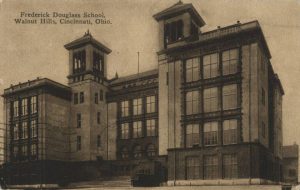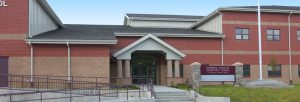 1855: Dangerfield Earley’s School
1855: Dangerfield Earley’s School
Before the Civil War many African Americans settled in Cincinnati. The city had a separate system of Colored Public Schools for their children. The suburb of Walnut Hills also had a private African American school run by Dangerfield Earley, minister of the First Church founded in 1856.
The Rev. Earley held the school at his home on Willow Street (now Preston) one block east of the Spencer Center site. The Earley family played a vital role in African American schools in Walnut Hills for another century. This window in the Bethel Baptist Church, built in 1895, memorializes the first generation of the family.
Elm Street School 1872
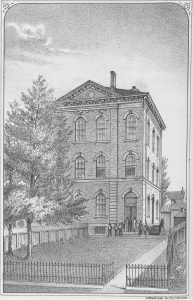 Walnut Hills joined the city of Cincinnati in 1870. Cincinnati Public Schools built two segregated facilities. The Elm Street Colored School opened in 1872. The Spencer Center today sits on the same block.
Walnut Hills joined the city of Cincinnati in 1870. Cincinnati Public Schools built two segregated facilities. The Elm Street Colored School opened in 1872. The Spencer Center today sits on the same block.
In 1887 the State of Ohio repealed the “Black Laws” and said all students could go to the same public schools. Racial prejudice banned Black teachers in classrooms with white students.
African American parents in Walnut Hills kept their separate school. They believe their children would get more attention from Black teachers. Most of the Elm Street faculty had more education than teachers in other public schools. The teachers acted as leaders in the Community.
The Elm Street School accepted students from anywhere in the city. It began a long tradition of district-wide special schools in Walnut Hills. As African American schools downtown closed, some parents sent their children up the hill for the excellent academics and supportive environment.
Frederick Douglass escaped slavery before the Civil war. He wrote and gave speeches urging freedom for his people. After the War he became a leader in the African American community. The Black teachers chose the name Frederick Douglass School in 1902 for the school on Elm Street. About the same time the street was renamed Alms Place.
Fredrick Douglass School 1911
By 1910 there were too many students to fit in the old Elm Street building. Cincinnati Public Schools built a handsome new Frederick Douglass School in 1911. The school served as a center for the African American community in Walnut Hills. It continued to attract students from other neighborhoods.
The 1911 building created new public space. A 350-seat auditorium hosted events in the evenings. Adults could use the Douglass Library after school. (This Public Library for African Americans allowed the nearby Walnut Hills branch to serve mostly white residents.)
The school also offered basic social services. It included a lunch room with a kitchen. At the time, many apartments in the neighborhood shared inadequate bathrooms with other families. The school provided showers for boys and girls, with separate attendants. The building also had a doctor’s office staffed part time by the Public Health Department.
Cincinnati’s African American population nearly doubled during the “Great Migration” of the 1910’s. The new Frederick Douglass School continued the tradition of hiring well-educated African American women and men as teachers. The school played an even more vital role in the community.
Frederick Douglass Colony School 1927
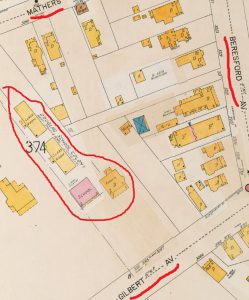 In the late 1920’s, there were too many African American students to fit in the main Frederick Douglass School building. Cincinnati Public Schools bought some houses north of Gilbert Avenue and made them into a school in 1927. They called it the Frederick Douglass Colony School.
In the late 1920’s, there were too many African American students to fit in the main Frederick Douglass School building. Cincinnati Public Schools bought some houses north of Gilbert Avenue and made them into a school in 1927. They called it the Frederick Douglass Colony School.
Much of the school’s growth came from the large Model Homes development on the other side of Gilbert Avenue from the main Douglass School. The Colony School mostly served younger students. These children did not have to cross the busy street. As the students got older, they could make the longer walk to “Big Douglass.” The new apartments had their own bathrooms with hot water, and public space for residents so the Colony had few of the services at the main building. (Many students lived in older, cold-water flats; the lack of bathing facilities caused considerable hardship.)
Frederick Douglass School grew with continued African American migration to Cincinnati in the 1930’s, ‘40’s and ‘50’s. Cincinnati Public Schools constructed several small classroom buildings around both the main building and the colony.
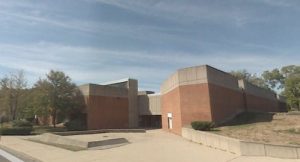 Frederick Douglass School 1980
Frederick Douglass School 1980
In the late 1950’s through the 80’s, Cincinnati Public Schools tried to racially integrate its facilities. With many other public schools in Walnut Hills, the 1911 building seemed too big. The district constructed a new Frederick Douglass School on the old playground.
The city hoped there would no longer be a need for segregated services. Cincinnati Public Schools tore down the 1911 building. (The demolition was difficult.) The new building had no large auditorium or branch library; improved housing conditions meant the school no longer provided bathing facilities. For more than 25 years the 1980 building served Walnut Hills as a neighborhood school.
Frederick Douglass Elementary School 2008
In 2008 Cincinnati Public Schools built the fifth Frederick Douglass School.
The facility is a better fit for younger students than the 1980 structure. With classrooms clustered around open spaces, it allows more modern teaching methods. The “Panther Pride” at the school continues the tradition of educational excellence for students in the largely African American community around the school.
The Donald and Marian Spencer Center 2017
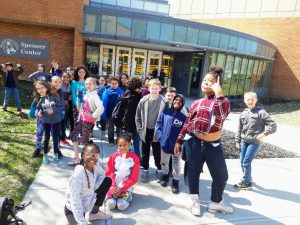 The 1980 Frederick Douglass building served Cincinnati Public Schools for several years by housing an Alternative to Suspension (A2S) Program.
The 1980 Frederick Douglass building served Cincinnati Public Schools for several years by housing an Alternative to Suspension (A2S) Program.
